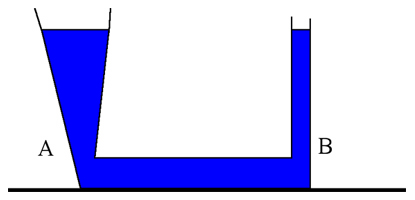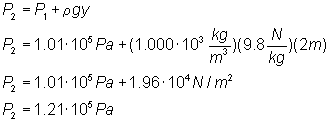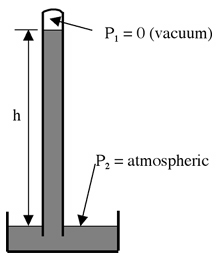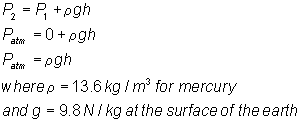 username@email.com
username@email.com
When we increase our altitude, our ears sometimes “pop” indicating that we experienced a change in air pressure. When we swim deep under water, we feel the pressure increasing. Pressure, then, is dependent on our vertical location in a liquid or a gas. The pressure (P) exerted by a fluid on an object is defined as the ratio of the perpendicular force (F) of the fluid on the object to the surface area (A) over which the force acts:
P2 – P1 = r g h
Fluids such as water are considered to be incompressible, meaning that their density does not change significantly with pressure. This simplifies the calculation for pressure underwater since density (r) is not a function of depth (h) from the top of the water. The pressure under water is calculated using the following formula:


Since both A and B are the same distance below the water, their pressures will be the same and are calculated as follows:

Now that we understand how we can measure pressures at different depths in incompressible fluids, is there a way we can measure air pressure?
A mercury barometer is a simple device that measures our atmospheric pressure. It consists of a sealed tube that that is filled with mercury and inverted so that the open end is upside-down in a pool of mercury.

Since mercury is considered to be incompressible, we can apply the pressure formula from the previous section:


In our discussion of fluids so far, we have focused on fluids that are in static equilibrium (i.e., at rest). What happen when fluids are in motion? You might expect that pressures go up when a fluid is in motion, but just the opposite happens. When the speed of a fluid increases, its pressure decreases.
When water flows through a pipe, the amount of water flowing per second is constant, even if the diameter of the pipe changes. For example, when you put your thumb over the end of a garden hose, the water has to move faster through the closed end so that the flow rate (gallons per second) remains the same. This means that water speeds up in narrow parts and slows down in wider parts so that the volume flow rate remains constant.
Daniel Bernoulli (1700-1782) discovered that speed, pressure, and elevation are related for incompressible fluids like water. Bernoulli’s principle can be stated as follows: if the elevation of the fluid does not change: when the speed of a fluid increases, its pressure drops. This aspect of Bernoulli’s principle is sometimes called the Venturi effect.
Now let’s apply Bernoulli’s principle to the water flowing through the tube pictured below.

Which section has the greatest volume flow rate?
The answer is D. Water cannot be created or destroyed and is also incompressible. Therefore, the volume flow rate (gallons per minute) must be constant throughout the pipe.
At which point does the water have the greatest speed?
The answer is C. The smaller the cross section, the greater the speed so that the volume flow rate remains constant.
At which point does the wall experience the MOST pressure?
The answer is A. The greatest pressure is where the speed is the least according to Bernoulli’s principle.